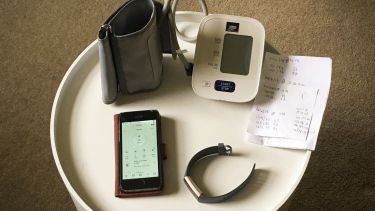Researchers from the Department of Sociological Studies at The University of Sheffield, along with colleagues from the Universities of Sussex and Brighton, have launched the House of Tracking, an interactive web tool that showcases some of the empirical findings of the ‘Tracking Ourselves?’ research project.
‘Tracking Ourselves?’, a Leverhulme Trust funded project, is concerned with people’s everyday self-monitoring practices, focusing on the cases of blood pressure (BP) and body mass index (BMI). The project was particularly interested in the social and cultural reasons for, and consequences of, our increasing engagement with self-monitoring for health, self-care and fitness. It involved qualitative interviews and participants taking photographs of their monitoring activities (such as taking BP or weight measurements) over a period of six months.
“Health policy increasingly stresses the benefits of us all participating more in our own health care, and self-tracking technologies are seen as having a promising role in this. But why people engage with monitoring, what they do in practice, and how this links (or doesn’t link) with the clinic still needs to be worked through. We wanted to show the realities of everyday tracking, thinking about why people do this, who and what is involved and how people make sense of this. Monitoring can bring pleasure and it can be useful, but not necessarily in ways that manufacturers, policy-makers and professionals expect.” - Dr Kate Weiner (PI)
Our findings reveal that:
- People acquire monitors from a variety of places and for a variety of reasons. Sometimes, monitoring is done in an impromptu fashion, such as jumping on someone’s bathroom scales or trying on their blood pressure monitor when visiting their house. Sometimes, people begin to self-monitor following a reading at the gym (such as a gym induction) or a health check at their local GP surgery.
- Where people keep self-monitoring devices is important. For instance, where the device is placed might be used to encourage or discourage self-monitoring, if someone keeps it close to hand to increase the chances of taking a reading, or puts it away to keep it ‘out of sight, out of mind’.
- Whilst it might be called self-tracking, it is often very much a shared practice. Our participants described how they encouraged their partners to monitor, how they monitored together, or looked out for one another if monitoring became a source of worry. Participants often share monitors, weigh together, or share results.
- Self-monitoring can become part of the fabric of everyday life – people might take their blood pressure in the morning when having a cup of tea and reading a morning newspaper, or jump on the scales before heading in to the shower. The practices of self-monitoring are not always distinct activities, but can become part of everyday routines and rhythms.
- Self-monitoring can be a private activity. We found that some of our participants kept their monitoring to themselves, such as not letting on they were regularly checking their blood pressure so as not to concern other family members, especially their children. It was common to keep records private, such as a weekly weigh-in chart.
- People make records of health monitoring in diverse ways – some on paper, some on computers, some through monitoring devices which may be networked, some keep track in their heads. Some records are created for personal use only, and other times individuals create records together or with a view to sharing with someone they may be monitoring with (e.g. to help a project of losing weight together) or a healthcare professional. We found that participants don’t always record their results regularly, but often do so intermittently, selecting the data they want to record and sometimes only writing down the positive or negative results. Our participants showed us how they kept spreadsheets visible at home to remind them to record. Others noted how apps can remind us to take a reading too often. Sometimes, records of readings were simply noted down on slips of paper, the backs of envelopes, stashed away or lost in the midst of people’s busy lives.
The house of tracking tool has been designed to show some of the findings from the project. The participants’ quotes and images have been located around the home to demonstrate how self-monitoring is experienced across different spaces, at different times, alone, with others and how monitors find a place in everyday life. The tool draws attention to the links between devices and the spaces in which they are used, hidden and shared in domestic life.
“We were interested in the everyday lives of tracking. The House of Tracking tool offers both visual images and spoken narratives about some of the everyday domestic stories about tracking - the accounts situated within the interactive house reveal the hidden worlds of everyday tracking. They go beyond the normal health promotion stories and give attention to people’s everyday logics rather than the ‘rights’ and ‘wrongs’ of self-monitoring.” - Dr Kate Weiner (PI)
This tool has been created for anyone with an interest in tracking for themselves or supporting others (family or friends) in thinking about tracking. It also works as a tool for healthcare professionals who support self-monitoring, by providing them an insight into the day-to-day practices of monitoring behind closed doors.
House of Tracking: try the tool
Read more information about the project or contact the PI Dr Kate Weiner via her email k.weiner@sheffield.ac.uk

